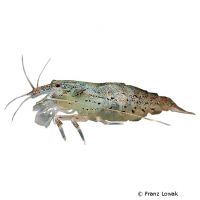Green Lace Shrimp (Atyoida pilipes)
| Green Lace Shrimp Atyoida pilipes | |
|---|---|
| Name | Green Lace Shrimp |
| Name Lat. | Atyoida pilipes |
| Family | Shrimps |
| Family lat. | Atyidae |
| Order | Decapoda |
| Order lat. | Decapoda |
| Origin | Southeast Asia |
| Habitat | Streams, rivers |
| Diet | Plankton, leaves, shrimp food |
| pH | 6.0-8.0 |
| Behavior | Peaceful |
| Keeping | Group |
| Care Level | Moderate |
| Reproduction | Marine larval stages |
| Breeding | Difficult |
| Life Span | 6-10 years |
| Protection | No |
| Metric Units | |
| Size | 4-5 cm |
| Temperature | 22-28 °C |
| Hardness | 5-20 °dH |
| Aquarium | 50 l |
| US Units | |
| Size | 1.6"-2" |
| Temperature | 72-82 °F |
| Hardness | 89-356 ppm |
| Aquarium | 15 gal |
Distribution and habitat
The dwarf fan shrimp are widely distributed from southern Japan, the Philippines, through the eastern Indonesian islands to New Guinea and Fiji. They live in fast-flowing streams and rivers that empty into the sea, where they live among stones, roots and plants.
Maintenance
They require a well-structured aquarium with many roots, some robust plants, large stones and boulders, and a medium to strong current. The substrate of sand or gravel should be partially covered with foliage (e.g. sea almond leaves, oak leaves), rotting plant material and mulm.
No ammonia, ammonium and nitrite should be detectable in the aquarium water, the nitrate value should not exceed 100 mg/l. To ensure the water quality and oxygen content, a filter and heater adapted to the size of the aquarium is required, as well as lighting for the species-appropriate day-night rhythm of the animals. When choosing the filter, special care should be taken to ensure that the animals cannot be sucked in.
Diet
In nature, they filter detritus, zoo and phytoplankton, and tiny insect larvae from the current with their scissor legs formed into fans. They are easily fed with cyclops, daphnia, artemiauplia, microworms, spirulina and finely ground shrimp food supplemented with dried, crushed nettle, oak, beech and walnut leaves
Unaccepted food must be vacuumed up after 2-3 hours. Regular and varied feeding promotes health and increases resistance.
Behaviour and compatibility
They should be kept in a group of at least five animals. During the day they usually stay hidden. Due to their special feeding habits, they are not a danger to other shrimp or fish. They can be socialized well with calm fish that do not disturb them while feeding
Basically, only compatible animals with similar demands on water conditions and water temperature should be socialized.
Reproduction and breeding
Males have significantly larger anterior walking legs than females, whose abdominal carapace is extended downward.
Reproduction occurs through marine larval stages. Larvae develop in the brackish and saline waters of estuaries. The juvenile shrimp migrate back to inland waters
There are no known reports of successful breeding in the aquarium.
Important
In their wide range there are numerous variants with differently colored markings, which can be light brown, reddish or greenish. Therefore, there is often confusion and misnomers.
If the animals frequently scan the bottom with their fans, then they receive too little food in the current.
Socialization with crayfish is not recommended, as they could injure the shrimp after molting.
The well-being of the animals should be checked regularly. The temperature should be checked daily, the pH, hardness and nitrate value at least every 14 days. Regular partial water changes are recommended, even if the contaminant level has not yet reached the upper limit. Sudden changes in water quality should be avoided. Newly introduced animals must be accustomed slowly to the water in the aquarium.
Further literature can be found in your pet store.
References
Text: petdata; Image: Franz Lowak
Source: KARGE & KLOTZ (2007): Süßwassergarnelen aus aller Welt, Dähne Verlag; ENGELMANN & LANGE (2011): Zootierhaltung - Tiere in menschlicher Obhut: Wirbellose, Verlag Harri Deutsch
